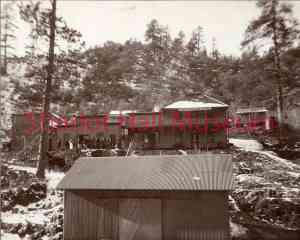South Poland Hotel in Winter
details
Unknown Unknown citn105p.jpg CI-TN-105 B&W 1200-0105-0000 citn105p Print 8x10 Historic Photographs 1890s Reproduction requires permission. Digital images property of SHM Library & ArchivesDescription
South Poland Hotel and Saloon, Walker District, Poland, Arizona.
The South Poland Hotel and Saloon was the pride of proprietor, Ed Trenberth. He appears at the far left of this photograph in the white apron.
Poland was the westernmost town in the Walker District and one of the busiest, thanks to a branch line of the SF & PP railroad. Located nine miles southeast of Prescott, at the northern foot of Big Bug Mesa, the town was named after Davis R. Poland from Tennessee and saw its prime in 1902 with a population exceeding 800.
From 1900 until about 1912, intermittent production was made with a 20-stamp mill. The 1907 yield was $130,465 in gold and 16,609 ounces of silver. The total output for this period is estimated at $750,000, probably mostly in silver.
Purchase
To purchase this image please click on the NOTIFY US button and we will contact you with details
The process for online purchase of usage rights to this digital image is under development. To order this image, CLICK HERE to send an email request for details. Refer to the ‘Usage Terms & Conditions’ page for specific information. A signed “Permission for Use” contract must be completed and returned. Written permission from Sharlot Hall Museum is required to publish, display, or reproduce in any form whatsoever, including all types of electronic media including, but not limited to online sources, websites, Facebook Twitter, or eBooks. Digital files of images, text, sound or audio/visual recordings, or moving images remain the property of Sharlot Hall Museum, and may not be copied, modified, redistributed, resold nor deposited with another institution. Sharlot Hall Museum reserves the right to refuse reproduction of any of its materials, and to impose such conditions as it may deem appropriate. For certain scenarios, the price for personal usage of the digital content is minimal; CLICK HERE to download the specific form for personal usage. For additional information, contact the Museum Library & Archives at 928-445-3122 ext. 14 or email: orderdesk@sharlot.org.




